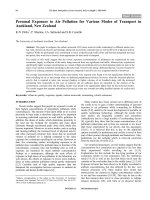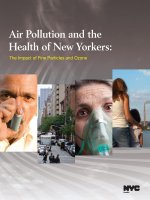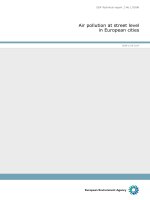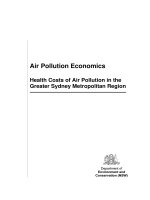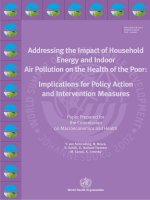Daily air pollution time series analysis of Isfahan City docx
Bạn đang xem bản rút gọn của tài liệu. Xem và tải ngay bản đầy đủ của tài liệu tại đây (218.89 KB, 9 trang )
R. Modarres
and A. Khosravi Dehkordi
Daily air pollution time
Int. J. Environ. Sci. Tech.
© Autumn 2005, Vol. 2, No. 3, pp. 259-267
Daily air pollution time series analysis of Isfahan City
1
R.
Modarres and
2*
A.
Khosravi
Dehkordi
1
Faculty of Natural Resources, Isfahan University of Technology, Isfahan, Iran
2
Department of Environmental Sciences, Graduate College of Natural Resources, Isfahan University of Technology, Isfahan, Iran
Received 25 May 2005; revised 11 June 2005; accepted 18 July 2005; onlined 30 September 2005
*Corresponding Author, E-mail:
Introduction
The limitless of air pollution range and sources
have forced pollution managers to apply new
methods in air pollution control and monitoring.
Development and use of statistical and other
quantitative methods in the environmental sciences
have been a major communication between
environmental scientists and statisticians (Herzberg
and Frew, 2003). This approach is called top-down
approach which starts with statistical analysis of
collected air pollution data (Lee, 2002). In recent
years many statistical analysis have been used to
study air pollution as a common problem in urban
areas. The common descriptive statistical approach
used for air quality measurement and modeling is
rather limited as a method to understand the behavior
and variability of air quality. Different techniques
have been used for air quality monitoring systems.
Vo igt et al., 2004 applied principle component
analysis in order to evaluate different air pollutants
like ozone (O
3
), nitrogen dioxide (NO
2
) and carbon
monoxide (CO) in 15 European member states. Many
investigators have used probability models to explain
temporal distribution of air pollutants (Bencala and
Seinfeld, 1979, Yee and Chen, 1997). Time series
analysis is a useful tool for better understanding of
cause and effect relationship in environmental
pollution (Schwartz and Marcus, 1990, Salcedo et
al., 1999, Kyriakidis and Journel, 2001). The principle
aim of time series analysis is to describe the history
of movement of a particular variable in time. Many
authors have tried to detect changing behavior of
air pollution through time using different techniques
(Salcedo et al., 1999, Hies et al., 2000, Kocak et
al., 2000, among others). Many others have tried to
relate air pollution to human health through time
series analysis (Gouveia and Fletcher, 2000, Roberts,
2003, Touloumi et al., 2004). The object of this study
is to examine daily time series analysis of some air
pollutants in Isfahan City, in the center of Iran. The
average daily air pollution concentrations (APC) of
SO
2
, CO, CH
4
, NO
2
, NO, non-CH
4
and O
3
were
selected from March 2003 to March 2004.
Material and Methods
Descriptive analysis
The classical descriptive analysis is the first
statistical analysis dealing with any data. Mean,
standard deviation (STDEV), maximum and
minimum value of selected data sets are usually
calculated to have preliminary knowledge of selected
variables. The calculation of coefficient of variation
(cv) helps the investigator to overcome the problem
of different levels and units of variables in order to
compare them. Coefficient of Skewness (cs) and
Kurtosis (ck) are other measures which may be used
to characterize the symmetry and flatness of the
probability density function of a time series,
respectively (Windsor and Toumi, 2001). Because
of high order, kurtosis is particularly sensitive to
extremes or intermittent fluctuations and, therefore,
a useful indicator of intermittency. Highly intermittent
time series have a higher kurtosis. However,
Abstract
Different time series analysis of daily air pollution of Isfahan city were performed in this study. Descriptive analysis
showed different long-term variation of daily air pollution. High persistence in daily air pollution time series were
identified using autocorrelation function except for SO
2
which seemed to be short memory. Standardized air pollution
index (SAPI) time series were also calculated to compare fluctuation of different time series with different levels. SAPI
time series indicated that NO and NO
2
, CH
4
and non-CH
4
have similar time fluctuations. The effects of weather condition
and vehicle accumulation in Isfahan city in cold and warm seasons are also distinguished in SAPI plots.
Key words: Air pollution, time series, ACF, non linear dynamic, SAPI, Isfahan
R. Modarres
and A. Khosravi-Dehkordi
Daily air pollution time
descriptive analysis is of rather limited value due to
the large variability associated with air quality data
through time (Salcedo, et al., 1999).
Time series analysis
A time series is a set of observations that are
arranged chronologically. In time series analysis, the
order of occurrence of the observation is crucial. If
the chronological ordering of data were ignored,
much of the information contained in time series
would be lost. A variety of different important
terminologies in time series analysis are existence
such as stationarity, periodicities and trend which
fall into temporal categories of air pollutant
concentration (Klemm and Lange, 1999, Lee, et al.,
2003). Stationarity of a process can be qualitatively
interpreted as a form of statistical equilibrium.
Therefore, the statistical properties of the process
are not a function of time. For interpretation
purposes, it is often useful to plot Autocorrelation
function (ACF) against lag time, K. ACF is a simple
graphical method to find time relationship of an event.
The sample autocorrelation coefficient is written as
(Box and Jenkins,1976):
k=0,1, …,N
Where N is the total length of record, K is lag time,
t
X
is observation at time t and
X
is the mean of
series. All
k
r
lie between -1 and +1 and values
significantly above zero denote correlation at the
given lag. ACF can also tell us whether the
observation depends on time or not. When ACF
decays rapidly to zero after a few lags, it may be an
indication of stationarity in the series, while a slow
decay of ACF may be the indication of
nonstationarity (Salas, 1993, Hipel and McLeod,
1994). Strict stationarity means that there is no
systematic change in mean (no trend), no systematic
change in variance, and strictly periodic variations
have been removed. Quantitatively, this means that
the joint distribution of X(t1), …, X(tn) is the same
as the joint distribution of X(t1+t),….,X(tn+t), for all
t1,…tn. This means that shifting the time origin by t
has no effect on the joint distributions, which only
depend on the time intervals between t1,t2,…,tn.
Second-order stationarity for weak stationarity. In
other words, a finite memory of the series leads to a
gradual decline of the envelope of the ACF (Klemm
and Lange, 1999). Another way to investigate
whether a series is time dependent or not is time
series regression (Bowerman and O’Connell, 1993).
The polynomial time regression between dependent
variable, yt and time is written as follows:
t
p
p
2
210t
t ttY ε+β++β+β+β=
Where
0
β
to
p
β
are the parameters of regression
equation and least square point estimates of them
may be obtained by using regression techniques. For
statistical inference on the significant of regression
and parameters, the reader is referred to Bowerman
and O’connel (1993).
Standardized time series
The above analysis will show us whether air
pollutant are dependent on time or not but in air
pollution time series analysis, it would be useful to
find time periods of risky air pollution levels. In order
to compare different air pollutants with different
levels and units, we use standardized air pollution
index which is written as follows:
Where
i
P
is the pollutant concentration at time
i,
P
and
σ
are the mean and standard deviation of
the series and SAPI is the Standardized Air Pollution
Index. Standardized air pollution index is not only
useful to determine risky periods of air quality
characteristics but to define the risky periods as well.
It is also possible to determine air pollution
interaction through time using cumulative SAPI. The
ASAPI will disclose the cumulative risky periods of
air quality and is useful in air health monitoring.
Results
Descriptive analysis
The descriptive statistics of selected daily air
pollutions are presented in Table 1. As the
coefficient of variation (cv) is a measure of variation
over time (Lee, 2002), the comparison of pollutants
indicates that NO has the highest variation over time
while CH
4
has the smallest variation. The degree of
variation decrease in the order:
NO<NO
2
<SO
2
<TSP<CO<non-CH
4
<O
3
<CH
4
. This
variation may be the result of variation in generating
resources or weather condition. The coefficient of
skewness (cs) measures the relative skewness of
frequency distribution; as time series, air pollution
concentration data are characterized buy strongly
right-skewed frequency distribution in this study like
other previous studies by Georgopoulos and Seinfeld
2
N
1t
t
kt
kN
1t
t
k
)XX(
)XX)(XX(
r
−
−−
=
∑
∑
=
+
−
=
(1)
(2)
σ
−
=
PP
SAPI
i
(3)
260
R. Modarres
and A. Khosravi-Dehkordi
Daily air pollution time
(1982) and Lee (2002). The degree of right-
skewness decrease in order: NO<NO
2
<SO
2
<non-
CH
4
<TSP<CO<CH
4
<O
3
.
The higher ck of most of the pollutants indicates
intermittency in most of air pollutants, except for
CH
4
, CO and O
3
. Non-CH
4
is perhaps the nearest
air pollutants to Normal distribution with cs=1 and
ck=3. The degree of kurtosis decrease in order:
NO<NO
2
<SO
2
<non-CH
4
<TSP<CH
4
<CO<O
3
.
NO
2
(ppb)
NO
(ppb)
CO
(ppm)
CH
4
(ppm)
non-CH
4
(ppm)
TSP
(µg/m
3
)
O
3
(ppb)
SO
2
(ppb)
Pollutant
351 351 344 323 323 337 349 350 Sample size (day)
75.3 27.5 1.7 6.2 0.42 137.4 87.5 39.7 Max.
17.6 4 0.78 3.9 0.15 44.6 48.4 10.5 Mean
3.15 0.69 0.23 2.30 0.05 12.4 3.46 0.41 Min
10.7 2.8 0.3 0.7 0.05 18.7 14.1 5.6 STDEV
61.2 70.7 37.2 18.7 33.3 42 29.1 53.2 cv
1.99 2.87 0.32 0.27 0.96 0.76 0.03 1.47 cs
5.6 16.4 -0.37 -0.09 3.36 1.6 -0.66 4.24 ck
1-42 1-17 1-41 1-48 1-45 1-48 1-72 1-6
Significant
autocorrelations
(lags)
Table 1: Descriptive statistics of selected air pollutants of Isfahan city in 2003
Perhaps the most interesting result of descriptive
analysis is small value of cs and ck of O
3
. It is well
known that high O
3
concentration is produced only
when sunlight is strong (almost during summer in
Isfahan city). Therefore it is assumed that the
difference between low and high concentration is
large, resulting in the largest skewness and variation
in all examined air pollutants (Lee, 2002). The result
of this study is exactly in the opposite, where O
3
has the minimum values of skewness and variation.
The correlation matrix (Table 2) also indicates the
time correlation between different pollutants. High,
positive correlations between chemically-similar
pollutants like NO
2
and NO, CH
4
and non-CH
4
are
appealing. The positive correlation indicates
synchronous time fluctuations of air pollutants. The
different time correlation behavior of the pollutants
is further discussed in section 3.3.
Time series results
The first step in time series analysis is to draw
time series plot. Time series plot can give a
Pollutants SO
2
NO
2
NO CO O3 CH
4
nonCH
4
TSP
SO
2
1
NO
2
0.30 1
NO 0.12** 0.65* 1
CO -0.02 0.46* 0.45* 1
O3 -0.17* -0.48* -0.20* -0.04
CH
4
-0.08 -0.16 0.03 -0.01 0.52** 1
NonCH
4
-0.06 -0.31* -0.17* -0.23* 0.42** 0.43* 1
TSP 0.01 -0.20 0.01 -0.01 0.28* 0.20* 0.16* 1
Table 2: Correlation matrix of selected pollutants
(*: Significant at 5%, **: Significant at 1%)
preliminary understating of the time behavior of the
series. Fig.1. shows time series plot of selected time
series air pollution concentration. This Figure shows
different time behavior of air pollutants. For example,
the concentration of O
3
and TSP seem to have a
similar trend from the beginning of the year to the
end but the maximum and minimum concentrations
occur in different time. It is also obvious that SO
2
and NO have not a significant trend through time.
The fluctuations of NO
2
, SO
2
are more irregular at
the end of the year but the fluctuation of non-CH
4
is
more obvious at the beginning of the year.
261
R. Modarres
and A. Khosravi-Dehkordi
Daily air pollution time
The autocorrelation functions of the selected time
series also show different time stationarity of the
series. The autocorrelation functions of them are
presented in Fig. 2. The significant lags for all
selected pollutants are also presented in Table 1.
Except for SO
2
, all other pollutants show
nonstationarity (long serial correlation). The
amplitude of autocorrelation functions do not become
less pronounced for most of the series, except for
SO
2
. This is an indication that the memory of SO
2
is
finite. Time series regression was applied to the
selected series. The significant time regression was
selected based on R-Square and F-statistics.
Statistical inference for regression parameters was
done based on null hypothesis
0 :H
0210
=β==β=β
and all parameters
were significant at
%95=
α
. The parameters of
regression models are presented in Table 3 while
they are graphically presented in Fig. 1. Except for
SO
2
and NO, it is clear that most of the air pollutions
follow a non linear trend through time. The non linear
time dynamic of air pollution is probably the result
of non linear behavior of pollution generating
mechanism or weather fluctuations.
This non linearity behavior was also identified by
other investigators such as Kocak et al., 2000,
Salcedo et al., 1999 and Hies et al., 2000. The
linearity of NO and SO
2
also matches stationary
condition of the series indicated in Table 1. In other
words, the mean concentration of SO
2
and NO does
not vary through time.
SAPI time series
For analyzing air quality data, it is very important
to find the periods with adverse effect on public
health (Gouvvia and Fletcher, 2000, McKee et al.,
1993), even at historically low level of air pollution
(Touloumi et al., 2004). In order to find these
periods, standardized air pollution index was
calculated and presented in Fig. 3. The figure shows
that the fluctuation of air pollution differs through
time. For example, NO
2
does not differ from zero
for 219 (spring and summer) days but the
concentration is significant after that. In other words,
the adverse level of NO
2
appears mostly at the end
of the year. This may occur due to increase in gas-
fired home heating systems in winter. In contrast,
O
3
has negative values of SAPI at the end of the
year, approximately after day 219. This is the result
of inverse correlation between NO
2
and O
3
(Table
2) which indicates the interaction of O
3
as a
secondary pollutants and NO
2
as the primary
pollutants. Because O
3
is an oxidizing chemical and
its production requires the presence of sunlight, high
levels of O
3
occurs in summer (Fig. 1). SO
2
is again
attractive air pollution as the fluctuation of SO
2
around zero is approximately symmetric and
intermittent. SO
2
highest values of SAPI’s are
observed between 270 to 290 days.
The main source of SO
2
emission in Isfahan city
is intermittent road transport of diesel vehicles and
large power stations and industrial process around
the city. Other air pollutants indicate different periods
of high and low SAPI. The comparison of different
SAPI shows the inverse time behavior
characteristics of NO
2
and non-CH
4
. Whole NO
2
has negative value of SAPI at the beginning of the
year to almost 220
th.
day, the negative values of Non-
CH
4
begins approximately from 240
th.
day. The time
behavior of two hydrocarbon pollutants, CH
4
and
non-CH
4
, seems to be mostly similar to each other,
except for the beginning of the year when CH
4
begins to increase earlier than non-CH
4
.
Table 3: The properties of Regression models of the selected air pollution time series
R
2
F
3
β
2
β
1
β
0
β
Parameters
Pollutions
0.46 39.31 4×10
-6
0.002 -0.21 16.53 NO
2
0.53 38.04 - - 0.2 1.22 NO
0.58 42.93 1.4×10
-8
2×10
-5
0.005 0.35 CO
0.47 92.95 3×10
-7
-2×10
-4
0.035 2.69 CH
4
0.68 41.88 1×10
8
-7×10
-6
0.001 0.14 Non-CH
4
0.68 67.94 1.3×10
-5
-0.006 0.77 33.81 TSP
0.52 6.25 - - .007 9.2 SO
2
0.62 193.25 6×10
-6
-0.004 0.68 30.86 O
3
262
R. Modarres
and A. Khosravi-Dehkordi
Daily air pollution time
Non-CH4
0
0.1
0.2
0.3
0.4
0.5
1 51 101 151 201 251 301
Time (Day)
Concentration (ppm
)
O3
0
20
40
60
80
100
1 41 81 121 161 201 241 281 321
Time(Day)
Concentration(ppb)
NO2
0
20
40
60
80
1 41 81 121 161 201 241 281 321
Time(Day)
Concntration(ppm
)
SO2
0
10
20
30
40
1 22 43 64 85 106 127 148 169 190 211 232 253 274 295 316 337
Time(Day)
Concentration(ppm
)
TSP
0
40
80
120
1 41 81 121 161 201 241 281 321
Time (Day)
Concentration(µG/m3
CH4
2
3
4
5
6
7
1 50 99 148 197 246 295
Time (Day)
Concentration(ppm
)
CO
0
0.5
1
1.5
2
1 41 81 121 161 201 241 281 321
Time(Day)
Concentration(ppm
)
NO
0
5
10
15
20
25
30
1 41 81 121 161 201 241 281 321
Time(Day)
Concntration(ppm
)
Fig. 1: Time series plots of selected air pollutions (solid line) and fitted regression curves (dashed lines)
Concentration (ppm)
Time (Day)
Time (Day)
Time (Day)
Time (Day)
Time (Day)
Concentration (ppm)
Concentration (ppm)Concentration (ppm)
Time (Day)
Time (Day)
Time (Day)
Concentration (ppm)
Concentration (ppm)
Concentration (ppb)
Concentration (µg/m
3
)
O
3
NO
2
CH
4
CO
NO
SO
2
263
R. Modarres
and A. Khosravi-Dehkordi
Daily air pollution time
Fig. 2: Autocorrelation Function of selected pollutants, showing different stationarity behaviors
TSP
-0.2
0
0.2
0.4
0.6
0.8
12345678910111213141516
Lag (day)
ACF
NO2
-0.2
0
0.2
0.4
0.6
0.8
12345678910111213141516
Lag (day)
ACF
NO
-0.2
0
0.2
0.4
0.6
0.8
1 2 3 4 5 6 7 8 9 10111213141516
Lag (day)
ACF
SO
2
-0.2
0
0.2
0.4
0.6
12345678910111213141516
Lag (day)
ACF
CO
-0.2
0
0.2
0.4
0.6
0.8
123456789101112131415
Lag (day)
ACF
NCH4
-0.2
0
0.2
0.4
0.6
12345678910111213141516
Lag (day)
ACF
-0.2
0
0.2
0.4
0.6
0.8
1 2 3 4 5 6 7 8 9 10 11 12 13 14 15 16
Lag (day)
ACF
O3
-0.2
0
0.2
0.4
0.6
0.8
1
123456789101112131415
Lag (day)
ACF
Lag (day)
CH
4
ACF
NCH
4
CO
TSP
NO
2
NO
264
R. Modarres
and A. Khosravi-Dehkordi
Daily air pollution time
Fig. 3: Time series plot of standardized air pollution index (bars) and smoothed moving average line (solid line)
CH
4
-2.00
0.00
2.00
4.00
1 42 83 124 165 206 247 288 329
Time (Day)
SAPI
NO
-2
-1
0
1
2
3
4
1 42 83 124 165 206 247 288 329
Time (Day)
SAPI
TSP
-2.00
0.00
2.00
4.00
6.00
1 42 83 124 165 206 247 288 329
Time (Day)
SAPI
O
3
-0.08
-0.04
0
0.04
1 42 83 124 165 206 247 288 329
Time (Day)
SAPI
CO
-4.00
-2.00
0.00
2.00
4.00
1 42 83 124 165 206 247 288 329
Time (Day)
SAPI
NO
2
-2.00
0.00
2.00
4.00
6.00
1 42 83 124 165 206 247 288 329
Time (Day)
SAPI
Non-CH4
-2.00
0.00
2.00
4.00
6.00
1 42 83 124 165 206 247 288
Time (Day)
SAPI
SO
2
-2
0
2
4
6
1 42 83 124 165 206 247 288 329
Time (Day)
SAPI
Non-CH4
O
3
TSP
265
R. Modarres
and A. Khosravi-Dehkordi
Daily air pollution time
The increasing of hydrocarbon and carbon monoxide
air pollutants in summer is mostly due to high vehicle
concentration in Isfahan city as one of the main
tourist-attracting city of Iran. Another important
hydrocarbon resource is petrochemical industry in
the north west of the city. The role of hydrocarbons
in O
3
formation can be seen in Table 2 and Fig. 3.
The higher values of CO in winter are also the result
of increase in home heating systems with fossil fuels.
The other two related pollutants, NO and NO
2
also
show the same behavior. Although NO
2
has negative
values (low risky values) for the 220 day of the year
but NO has some positive (high risky values) values
between 90
th.
and 165
th.
days and then between
220
th.
and 300
th.
days. The effect of wind blowing in
fall and winter is the main reason of TSP decreasing
in cold seasons of Isfahan.
Discussion and Conclusion
Daily air pollution time series analysis of Isfahan
city was performed in this study and showed different
temporal behavior of different air pollutants. While
some pollutants like NO
2
and SO
2
show simple
temporal fluctuation through the year, other pollutants
show high fluctuation and have mostly non linear
trend through the year using time series regression.
High coefficient of variation and kurtosis in most of
the observed series also indicated non linearity
variation of air pollutants concentration through time.
Standardized time series analysis which let us
compare different pollutants with different levels and
units, indicates different health adverse periods from
the beginning of the year to the end. This different
time behavior is not only the reason of correlation
of different pollutants with each other but the
seasonal variation on increasing or decreasing air
pollutants as well. It was also shown that most daily
air pollution time series have high persistence of air
pollution conditions through time. This persistence
is not only dangerous for public health but also makes
air pollution management and control very difficult,
except for NO
2
and SO
2
. The influence of weather
conditions like rainfall, air moisture and wind
velocity-direction on air pollution temporal dynamics
is also very important in air pollution management
and control which will be ongoing author’s task to
investigate.
References
Bencala K. E. and Seinfeld J. H., (1979). On frequency
distribution of air pollutant concentrations. Atmos.
Environ., 10, 941-950.
Bowerman B. L. and O’Connel R. T., (1993). Forecasting
and Time Series, an Applied Approach, Duxbury,
Pasific Grove, 726.
Box G. E. P. and Jenkins G. M., (1976). Time Series
Analysis, Forecasting and Control. Revised Edition,
Holden – Day, San Francisco, California, 575.
Georgopoulos P. G. and Seinfeld J. H., (1982).
Statisticall distribution of air pollutant
concentrations, Environ. Sci. Technol., 401A-416A.
Gouviea N. and Fletcher T., (2000). Time series analysis
of air pollution and mortality: Effects by cause, age
and socioeconomic status. J. Epidemiol. Commun. H.,
54, 750-755.
Herzberg A. M. and Frew L., (2003). Can public policy
be influenced? Environmetrics, 14, 1-10.
Hies T., Treffeisen R., Sebald L. and Reimer E., (2003).
Spectral analysis of air pollutants. Part 1: elemental
carbon time series. Atmospheric Environment, 34,
3495-3502.
Hipel K. W. and McLeod A. E., (1994). Time series
modeling of water resources and environmental
systems, Elsevier, Amsterdam, 1013.
Klemm O. and Lange H., (1999). Trends of air pollution
in the Fichtelgebrige Mountains, Bavaria. Environ.
Sci. &Pollut. Res, 6, 193-199.
Kocak K., Saylan L. and Sen O., (2000). Nonlinear time
series prediction of O3 concentration in Istanbul.
Atmospheric Environment, 34, 1267-1271.
Kyriakidis P. C. A. G. Journel, (2001). Stochastic
modeling of atmospheric pollution: a spatial time
series framework. Part II: application to monitoring
monthly sulfate deposition over Europe. Atmos.
Environ., 35, 2339-2348.
Lee C. K., (2002). Multifractal characteristics in air
pollutant concentration time series. Water Air Soil
Poll., 135, 389-409.
Lee C. K., Ho D. S., Yu C., Wang C., Hsiao Y., (2003).
Simple multifractal cascade model for air pollutant
concentration (APC) time series. Environmetrics, 14
(2), 255-269.
McKee D. J., (1993). Health effects associated with
ozone and nitrogen dioxide exposure. Water Air Soil
Poll., 67, 11-35.
Roberts S., (2003). Combining data from multiple
monitors in air pollution mortality time series studies.
Atmos. Environ., 37, 3317–3322.
266
R. Modarres
and A. Khosravi-Dehkordi
Daily air pollution time
Salas J. D., (1993). Analysis and modeling of hydrologic
time series, In: D. R. Maidment (Ed.) Handbook of
Hydrology, McGraw Hill, New York.
Salcedo R. L. R., Alvim Ferraz M., Alves C. and Martins
F., (1999). Time series analysis of air pollution data.
Atmos. Environ., 33, 2361-2372.
Schwartz J. and Marcus A., (1990). Mortality and air
pollution in London: a time series analysis. Am. J.
Epidem., 131, 85-194.
Touloumi G., Atkinson R. and Terte A. L., (2004). Analysis
of health outcome time series data in epidemiological
studies. Environmetrics, 15, 101-117.
Voigt K., Welzl G. and Bruggemann R., (2004). Data
analysis of environmental air pollutant monitoring
systems in Europe. Environmetrics, 15 , 577-596.
Windsor H. L. and Toumi R., (2001). Scaling and
persistence of UK pollution. Atmos. Environ., 35, 4545-
4556.
Yee E., and Chen R., (1997) A simple model for the
probability density functions of concentration
fluctuations in atmospheric plumes. Atmos. Environ.,
31:, 991-1002.
267



